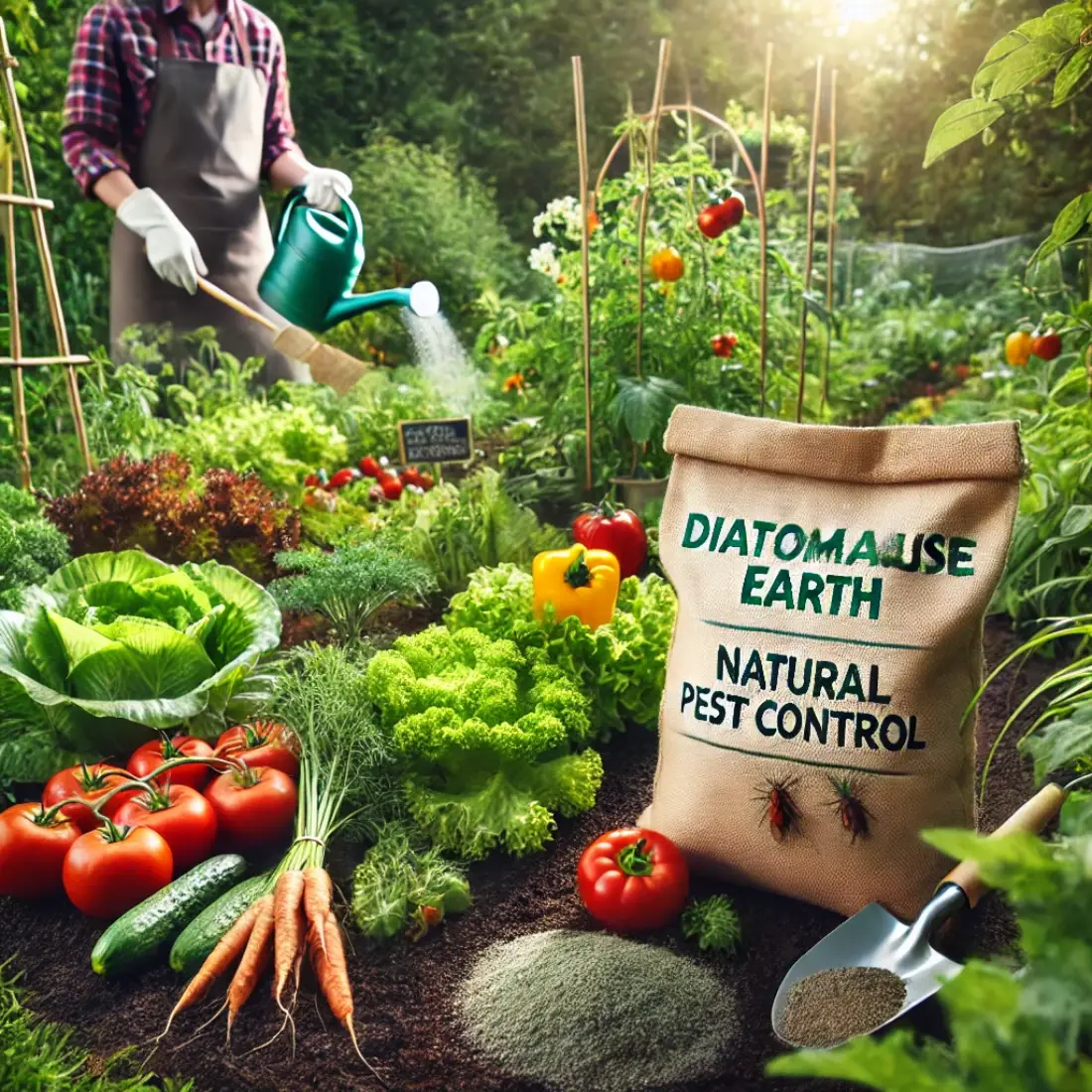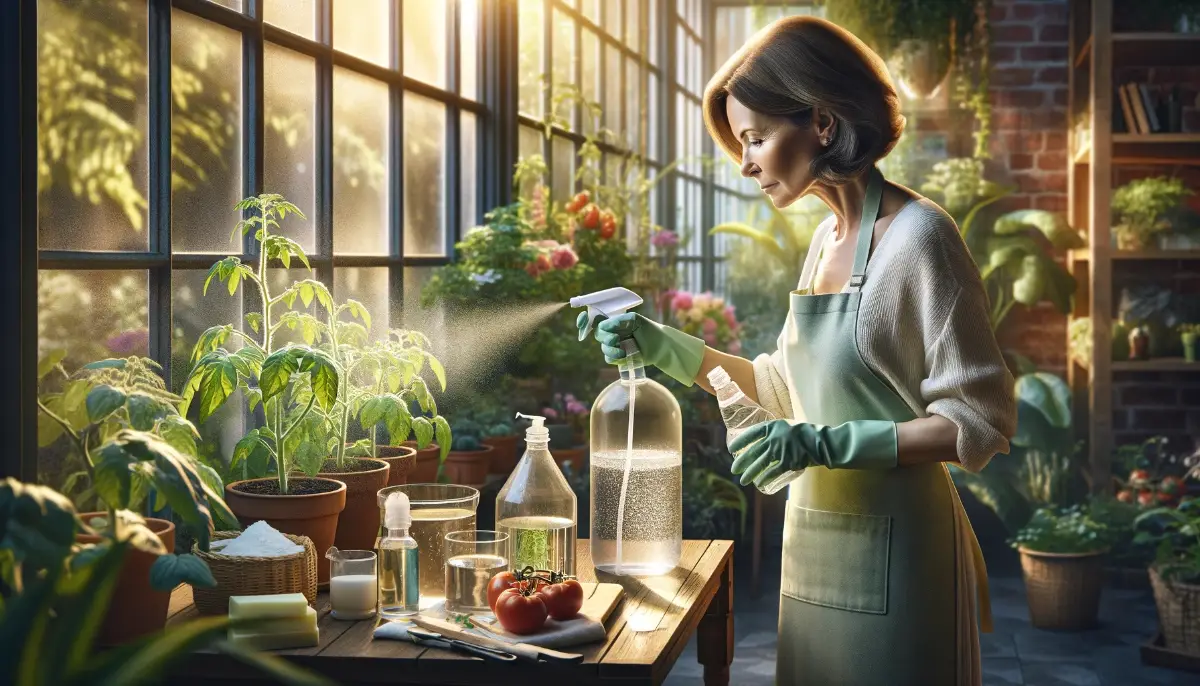Diatomaceous earth (DE) is a naturally occurring, soft, siliceous sedimentary rock that can be crumbled into a fine white to off-white powder. It is derived from the fossilized remains of tiny aquatic organisms called diatoms. Over millennia, these diatoms accumulated in the sediment of rivers, streams, lakes, and oceans, forming large deposits. The primary component of diatomaceous earth is silica, making up about 80-90% of its composition.
Diatomaceous earth is non-toxic to humans, pets, and wildlife, making it an eco-friendly alternative to chemical pesticides.
How Diatomaceous Earth Works
Diatomaceous earth (DE) functions as an effective natural pesticide due to its unique physical properties. The primary mechanism of DE’s action involves the microscopic structure of its particles. Composed of the fossilized remains of diatoms, these particles have sharp edges and are highly porous, resembling tiny shards of glass when viewed under a microscope.
When insects come into contact with diatomaceous earth, the sharp edges of the DE particles abrade their exoskeletons, which are crucial for their survival. The exoskeleton serves as a protective barrier that retains moisture within the insect’s body.
The abrasions caused by DE create tiny cuts and scratches on the exoskeleton, leading to the desiccation of the insect. Essentially, the insects dry out and die from dehydration.
This physical mode of action is different from chemical pesticides, which often rely on toxic substances to poison insects. Because DE works mechanically, pests cannot develop resistance to it over time, which is a significant advantage in pest control. This makes DE particularly valuable for organic gardening, where the use of synthetic chemicals is minimized or avoided.
Pest Control with Diatomaceous Earth
Diatomaceous earth (DE) is a highly effective natural pesticide, making it a popular choice for organic gardening. It controls a wide range of common garden pests, including aphids, beetles, ants, caterpillars, slugs, and mites. The fine powder is applied directly to the areas where pests are active.
Application Methods for Pest Control
Dusting: Using a duster or a powder applicator, lightly dust the leaves and stems of plants. Ensure thorough coverage, especially on the undersides of leaves where pests often hide.
Slurry Spray: Mix DE with water to create a slurry and spray it onto plants. This method is useful for covering larger areas and ensuring an even application.
Soil Amendment: Incorporate DE into the soil to target soil-dwelling pests. This also helps improve soil structure and drainage.
Safety Precautions
- Wear a mask to avoid inhaling the fine particles.
- Apply DE during dry weather, as it loses effectiveness when wet.
- Reapply after rain or heavy watering.
Diatomaceous earth is not only useful for pest control but also as a soil amendment. Its porous structure improves soil aeration and drainage, promoting healthy root growth.
Benefits of DE for Soil
- Water Retention: DE can absorb and retain moisture, making it available to plants during dry periods. This helps maintain consistent soil moisture levels.
- Nutrient Absorption: The silica content in DE can enhance the soil’s ability to retain and exchange nutrients, making them more accessible to plants.
- Soil Structure: Mixing DE into the soil improves its structure, especially in clay-heavy soils, preventing compaction and promoting better root penetration.
Benefits for Plant Health
Using diatomaceous earth in your garden can lead to healthier plants. Its natural properties help in disease prevention, improve root growth, and enhance overall plant vitality.
Disease Prevention
- DE can help prevent fungal infections by keeping the soil dry and reducing the humidity around the plant base.
- It acts as a barrier, deterring pests that could transmit diseases.
Improved Root Growth
- The improved soil structure and aeration promote deeper and more extensive root systems.
- Healthy roots are better at absorbing nutrients and water, leading to more vigorous plant growth.
Enhanced Plant Vitality
- Plants treated with DE tend to be more resilient to environmental stresses such as drought and pests.
- The additional silica can strengthen cell walls, making plants sturdier and less prone to damage.
How to Apply Diatomaceous Earth
Applying diatomaceous earth (DE) correctly is crucial for maximizing its benefits in organic gardening. Here are step-by-step instructions for various applications:
Dusting Plants
- Use a duster or powder applicator for precise application.
- Lightly dust the leaves, stems, and soil around the base of the plants.
- Focus on the undersides of leaves where pests tend to hide.
- Apply in dry weather, preferably in the morning when plants are covered with dew to help the powder stick.
Creating a Slurry
- Mix DE with water (ratio: 1 cup of DE to 1 gallon of water).
- Stir the mixture well to ensure even distribution.
- Pour the slurry into a spray bottle or garden sprayer.
- Spray the solution onto plants, ensuring thorough coverage.
- Allow the mixture to dry on the plants, forming a protective layer.
Soil Amendment
- Sprinkle DE directly onto the soil surface or mix it into the top layer of soil.
- Use a rake or garden fork to incorporate DE evenly.
- Apply around the base of plants to target soil-dwelling pests.
Treating Stored Grains:
- Mix DE with stored grains to protect them from insects.
- Use food-grade DE and follow recommended dosage guidelines.
Tips for Effective Use
Reapplication
- Reapply DE after rain or heavy watering, as moisture reduces its effectiveness.
- Monitor pest activity and reapply as needed.
Seasonal Considerations
- Apply DE in early spring to target overwintering pests.
- Use it during peak pest activity periods for best results.
Common Mistakes to Avoid
To ensure optimal results, avoid these common mistakes when using diatomaceous earth:
Overapplication: Applying too much DE can smother plants and beneficial insects. Use a light, even dusting for effective pest control without harming the environment.
Incorrect Timing: Applying DE during wet or windy conditions can reduce its effectiveness. Choose calm, dry days for application to ensure DE adheres to plants and soil.
Using the Wrong Grade: Always use food-grade DE for gardening and pest control. Pool-grade DE is chemically treated and unsafe for use around plants, animals, and humans.
Incompatible Uses: Avoid using DE in areas where it can be easily washed away or blown away. Do not use DE on flowering plants if you want to protect pollinators like bees.
FAQs about Diatomaceous Earth
What pests does diatomaceous earth control?
Diatomaceous earth effectively controls a wide range of garden pests, including ants, aphids, beetles, caterpillars, fleas, mites, slugs, and ticks. It works by abrading the exoskeletons of these insects, causing them to dehydrate and die.
Is diatomaceous earth safe for all plants?
Yes, diatomaceous earth is safe for all types of plants when used correctly. It does not harm plant tissues and can be applied directly to the soil, stems, and leaves. However, avoid overapplication and ensure it’s used in dry conditions for maximum effectiveness.
How often should I apply diatomaceous earth?
The frequency of application depends on pest activity and weather conditions. Generally, you should reapply diatomaceous earth after rain or heavy watering, as moisture can reduce its effectiveness. During periods of high pest activity, weekly applications may be necessary.
Can I use diatomaceous earth indoors?
Yes, diatomaceous earth can be used indoors to control pests like ants, bed bugs, cockroaches, and fleas. Apply it in areas where these pests are commonly found, such as along baseboards, under appliances, and in cracks and crevices. Ensure the area is dry before application.
Where can I buy diatomaceous earth?
Diatomaceous earth is available at garden centers, home improvement stores, online retailers, and some health food stores. Ensure you purchase food-grade DE for gardening and pest control purposes.
Is diatomaceous earth safe for pets and humans?
Yes, food-grade diatomaceous earth is safe for pets and humans when used as directed. However, it is advisable to wear a mask and goggles during application to avoid inhaling the fine particles. Keep pets and children away from the treated areas until the dust settles.
How do I apply diatomaceous earth to my garden?
You can apply diatomaceous earth by dusting it directly onto plants, mixing it into the soil, or creating a slurry to spray on foliage. Use a duster or applicator for even distribution and reapply after rain or heavy watering.
Can diatomaceous earth help with soil improvement?
Yes, diatomaceous earth can improve soil structure by enhancing aeration and drainage. It can also help with water retention and nutrient absorption, promoting healthier root growth and overall plant vitality.
What is the difference between food-grade and pool-grade diatomaceous earth?
Food-grade diatomaceous earth is safe for use in gardening, pest control, and even as a dietary supplement for humans and animals. Pool-grade diatomaceous earth, however, has been chemically treated for use in pool filtration systems and is not safe for use around plants, animals, or humans.
How does diatomaceous earth compare to chemical pesticides?
Diatomaceous earth is a natural, non-toxic alternative to chemical pesticides. It works by physically damaging the exoskeletons of insects rather than poisoning them, which means pests cannot develop resistance. It is safe for humans, pets, and the environment, making it ideal for organic gardening.










